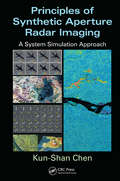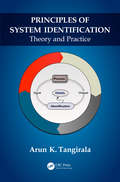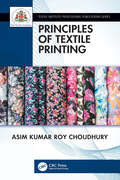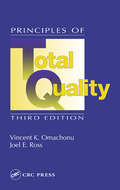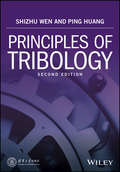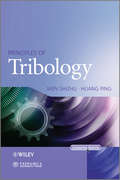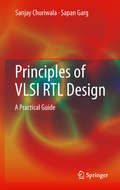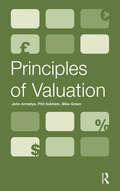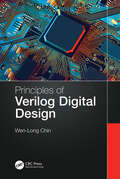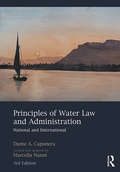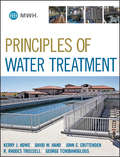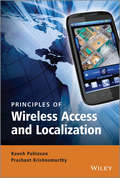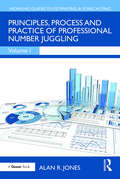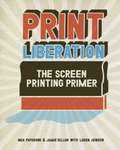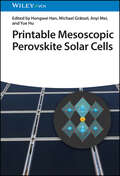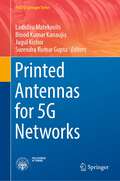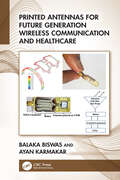- Table View
- List View
Principles of Synthetic Aperture Radar Imaging: A System Simulation Approach (Signal and Image Processing of Earth Observations)
by Kun-Shan ChenPrinciples of Synthetic Aperture Radar Imaging: A System Simulation Approach demonstrates the use of image simulation for SAR. It covers the various applications of SAR (including feature extraction, target classification, and change detection), provides a complete understanding of SAR principles, and illustrates the complete chain of a SAR operati
Principles of System Identification: Theory and Practice
by Arun K. TangiralaMaster Techniques and Successfully Build Models Using a Single ResourceVital to all data-driven or measurement-based process operations, system identification is an interface that is based on observational science, and centers on developing mathematical models from observed data. Principles of System Identification: Theory and Practice is an introductory-level book that presents the basic foundations and underlying methods relevant to system identification. The overall scope of the book focuses on system identification with an emphasis on practice, and concentrates most specifically on discrete-time linear system identification.Useful for Both Theory and PracticeThe book presents the foundational pillars of identification, namely, the theory of discrete-time LTI systems, the basics of signal processing, the theory of random processes, and estimation theory. It explains the core theoretical concepts of building (linear) dynamic models from experimental data, as well as the experimental and practical aspects of identification. The author offers glimpses of modern developments in this area, and provides numerical and simulation-based examples, case studies, end-of-chapter problems, and other ample references to code for illustration and training.Comprising 26 chapters, and ideal for coursework and self-study, this extensive text: Provides the essential concepts of identification Lays down the foundations of mathematical descriptions of systems, random processes, and estimation in the context of identification Discusses the theory pertaining to non-parametric and parametric models for deterministic-plus-stochastic LTI systems in detail Demonstrates the concepts and methods of identification on different case-studies Presents a gradual development of state-space identification and grey-box modeling Offers an overview of advanced topics of identification namely the linear time-varying (LTV), non-linear, and closed-loop identification Discusses a multivariable approach to identification using the iterative principal component analysis Embeds MATLAB® codes for illustrated examples in the text at the respective points Principles of System Identification: Theory and Practice presents a formal base in LTI deterministic and stochastic systems modeling and estimation theory; it is a one-stop reference for introductory to moderately advanced courses on system identification, as well as introductory courses on stochastic signal processing or time-series analysis.The MATLAB scripts and SIMULINK models used as examples and case studies in the book are also available on the author's website: http://arunkt.wix.com/homepage#!textbook/c397
Principles of Textile Printing (Textile Institute Professional Publications)
by Asim Kumar ChoudhuryPrinciples of Textile Printing discusses technical aspects of textile printing, covering almost all topics related to textile printing, including the types and quality of printing important for user satisfaction. It offers historical and introductory aspects of textile printing, styles and methods of printing, and printing and ancillary machines. Describes a variety of existing technologies and a wide range of designs created by applying colors in restricted portions using printing tools. Identifies technical, as opposed to artistic, aspects of textile printing. Covers a wide range of diverse and economical designs created by applying colors in restricted portions using printing tools. Discusses theoretical as well as practical aspects of textile printing. Explores a broad variety of printing types. The book aims to educate those readers from large printing houses as well as from cottage and smaller boutique printers so that their products meet fastness standards.
Principles of Total Quality
by Joel E. Ross Vincent K. OmachonuIn this era of global competition, the demands of customers are growing, and the quest for quality has never been more urgent. Quality has evolved from a concept into a strategy for long-term viability. The third edition of Principles of Total Quality explains this strategy for both the service and manufacturing sectors.This edition addr
Principles of Tribology
by Shizhu Wen Ping HuangUpdated to include the timely and important topics of MEMS and rolling friction, Principles of Tribology is a compilation of current developments from tribology research, coupled with tribology fundamentals and applications. Essential topics include lubrication theory, lubrication design, friction mechanism, wear mechanism, friction control, and their applications. Besides classical tribology content, the book also covers intersecting research areas of tribology, as well as the regularities and characteristics of the tribological phenomena in practice. Furthermore, it presents the basic theory, numerical analysis methods and experimental measuring techniques of tribology as well as their application in engineering. Newly expanded and updated to include new tribological material on MEMS and green tribology, its key concepts and applications Systematically brings the reader through fundamental theories, basic mechanisms through to the latest research Emphasizes practical tribological phenomena, supported by numerical analysis and experimental measurement techniques Discusses nano-tribology, thin film lubrication and its applications, topics which are growing in importance A comprehensive look at the fundamentals and latest research, this second edition of Principles of Tribology is an essential textbook for graduate and senior undergraduate students specializing in tribology and related mechanical engineering fields.
Principles of Tribology
by Shizhu Wen Ping HuangProfessors Wen and Huang present current developments in tribology research along with tribology fundamentals and applications, including lubrication theory, lubrication design, friction mechanism, wear mechanism, friction control, and their applications. In addition to classical tribology, Wen and Huang cover the research areas of the modern tribology, as well as the regularities and characteristics of tribological phenomena in practice. Furthermore, the authors present the basic theory, numerical analysis methods, and experimental measuring techniques of tribology as well as their applications in engineering. Provides a systematic presentation of tribology fundamentals and their applications Discusses the current states and development trends in tribology research Applies the applications to modern day engineering Computer programs available for download from the book’s companion site Principles of Tribology is aimed at postgraduates and senior-level undergraduates studying tribology, and can be used for courses covering theory and applications. Tribology professionals and students specializing in allied areas of mechanical engineering and materials science will also find the book to be a helpful reference or introduction to the topic. Companion website for the book: www.wiley.com/go/wen/tribology
Principles of Tropical Horticulture (Animal And Veterinary Science Ser.)
by David MidmorePrinciples of Tropical Horticulture leads the reader through a background of environmental influences and plant physiology to an understanding of production and post-harvest systems, environmental adaptation techniques and marketing strategies. Focusing on the principles behind production practices and their scientific basis, rather than detailed biological traits of each crop, this text outlines successes and failures in practices to date and sets out how the quantity and quality of horticultural produce can improve in the future. Case studies are frequently used and chapters cover the production of vegetables, fruit and ornamental crops, including temperate zone crops adapted to grow in the tropics.
Principles of VLSI RTL Design
by Sapan Garg Sanjay ChuriwalaSince register transfer level (RTL) design is less about being a bright engineer, and more about knowing the downstream implications of your work, this book explains the impact of design decisions taken that may give rise later in the product lifecycle to issues related to testability, data synchronization across clock domains, synthesizability, power consumption, routability, etc., all which are a function of the way the RTL was originally written. Readers will benefit from a highly practical approach to the fundamentals of these topics, and will be given clear guidance regarding necessary safeguards to observe during RTL design.
Principles of Valuation
by Mike Green John Armatys Phil AskhamAn entry level introduction to valuation methodology, this book gives a straightforward narrative treatment to the subject matter with a multitude of examples and illustrations, contained in an easy to read format.There is a strong emphasis on the practical aspects of valuation, as well as on the principles and application of the full range of valuation methods. This book will serve as an important text for students new to the topic and experienced practitioners alike. Topics covered include: property ownership concepts of value the role of the valuer property inspection property markets and economics residential property prices and the economy commercial and industrial property methods of valuation conventional freehold investment valuations conventional leasehold investment valuations discounted cash flow contemporary growth explicit methods of valuation principles of property investment.
Principles of Vegetable Oil Extraction
by Vivekanand Sadashiv VadkeThis book covers the technology of vegetable oil extraction, including theory, process technologies used for various oilseeds, machinery operation and design aspects. Pertinent topics are covered in two parts: mechanical expression and solvent extraction. The importance of each preparation operation is explained as related to oilseed structure, outlining the differences in the quality of prepared material from various oilseeds. It also covers modern press designs, designs of extractors, desolventisers and distillation line, and support equipment. Effect of each unit operation on final product quality, levels of safety and precautions in plant operation, and plant automation, are discussed. Finally, the book takes a peek at possible novel and green technologies to find solutions to problems faced by the industry. Features: Provides comprehensive coverage of vegetable oil extraction technology as applicable to major and minor oil-bearing materials. Explains the effects of each of the seed preparation steps on cell structure, and how it improves oil extraction. Describes mechanical expression technology in detail, including the design aspects of presses and seed preparation equipment. Explores the design of solvent extraction process equipment, including extractor, desolventiser, distillation and support. Discusses extraction plant safety, plant automation and utilities. This book is aimed at professionals, students and researchers in chemical and food engineering.
Principles of Verilog Digital Design
by Wen-Long ChinCovering both the fundamentals and the in-depth topics related to Verilog digital design, both students and experts can benefit from reading this book by gaining a comprehensive understanding of how modern electronic products are designed and implemented. Principles of Verilog Digital Design contains many hands-on examples accompanied by RTL codes that together can bring a beginner into the digital design realm without needing too much background in the subject area. This book has a particular focus on how to transform design concepts into physical implementations using architecture and timing diagrams. Common mistakes a beginner or even an experienced engineer can make are summarized and addressed as well. Beyond the legal details of Verilog codes, the book additionally presents what uses Verilog codes have through some pertinent design principles. Moreover, students reading this book will gain knowledge about system-level design concepts. Several ASIC designs are illustrated in detail as well. In addition to design principles and skills, modern design methodology and how it is carried out in practice today are explored in depth as well.
Principles of Water Law and Administration: National and International, 3rd Edition
by Dante A. Caponera Marcella NanniThis book, which was first published in 1992 and then updated in 2007, provides a tool for dealing with the legal and institutional aspects of water resources management within national contexts and at the level of transboundary water resources. Like its two previous editions, it seeks to cover all aspects that need to be known in order to attain good water governance, but it provides updates concerning developments since 2007. These relate, inter alia, to the following: - the “greening” of water law, which calls for the progressive integration of environmental law principles into domestic and international water law; - the adoption, by the International Law Commission in 2008, of the Draft Articles on the Law of Transboundary Aquifers, and subsequent developments;- the emergence of the right to water as a self-standing human right;- the adoption of domestic water laws supporting integrated water resources management (IWRM) and enhanced public participation in planning and decision making;- the integration into these laws of tools facilitating adaptive water management as a response to climate variability and change;- progress in the implementation of EU law;- recent international agreements and judicial decisions;- efforts of regional organizations other than the EU to steer cooperation in the management of transboundary water resources and the harmonization of national laws;- institutional mechanisms for the management of transboundary water resources (surface and underground). Unique in its scope and nature, the book identifies the legal and institutional issues arising in connection with water resources management and provides guidelines for possible solutions in a manner accessible to a wide range of readers. Thus, it is a useful reference for lawyers and non-lawyers — engineers, hydrologists, hydrogeologists, economists, sociologists — dealing with water resources within government institutions, river basin commissions, international organizations, financing institutions and academic institutions, among other things, and also for students of disciplines related to water resources.
Principles of Water Treatment
by John C. Crittenden David W. Hand R. Rhodes Trussell George Tchobanoglous Kerry J. HowePrinciples of Water Treatment has been developed from the best selling reference work Water Treatment, 3rd edition by the same author team. It maintains the same quality writing, illustrations, and worked examples as the larger book, but in a smaller format which focuses on the treatment processes and not on the design of the facilities.
Principles of Wildlife Conservation
by Ankur AwadhiyaWildlife tend our forests — they pollinate flowers, disperse seeds, eat insects that harm trees, and keep herbivores and diseases in check. They keep our forests healthy and resilient — ready and able to face and counter any challenges — such as global warming and climate change. They are the individual cogs that keep the forest machine functioning. And we desperately need our forests — to sequester carbon, to purify our air and water, to protect our soils from getting eroded, and to save our dams and waterways. Wildlife do need our care, concern and attention, but we also need our wildlife — perhaps much more sincerely. A majority of wildlife arrived on this planet much before humans, and the Earth belongs to them as well. So how do we conserve wildlife? This is the question that Principles of Wildlife Conservation seeks to answer. It presents a lucid — cogent yet simple narration about the why's and how's of conserving wildlife. It begins with the first principles — and thus requires no more prerequisite than an urge to seek knowledge. It is full of pictures and case studies from the field — to facilitate easy grasping of the subject. The book builds a solid foundation of the theory of wildlife conservation, and tops that up with experiences from actually doing wildlife conservation. In this way, it equips the reader to master both the science, and the art, of conserving wildlife.
Principles of Wireless Access and Localization
by Kaveh Pahlavan Prashant KrishnamurthyA comprehensive, encompassing and accessible text examining a wide range of key Wireless Networking and Localization technologiesThis book provides a unified treatment of issues related to all wireless access and wireless localization techniques. The book reflects principles of design and deployment of infrastructure for wireless access and localization for wide, local, and personal networking. Description of wireless access methods includes design and deployment of traditional TDMA and CDMA technologies and emerging Long Term Evolution (LTE) techniques for wide area cellular networks, the IEEE 802.11/WiFi wireless local area networks as well as IEEE 802.15 Bluetooth, ZigBee, Ultra Wideband (UWB), RF Microwave and body area networks used for sensor and ad hoc networks. The principles of wireless localization techniques using time-of-arrival and received-signal-strength of the wireless signal used in military and commercial applications in smart devices operating in urban, indoor and inside the human body localization are explained and compared. Questions, problem sets and hands-on projects enhances the learning experience for students to understand and appreciate the subject. These include analytical and practical examples with software projects to challenge students in practically important simulation problems, and problem sets that use MatLab.Key features:Provides a broad coverage of main wireless technologies including emerging technical developments such as body area networking and cyber physical systemsWritten in a tutorial form that can be used by students and researchers in the fieldIncludes practical examples and software projects to challenge students in practically important simulation problems
Principles of Woven Fabric Manufacturing
by Abhijit MajumdarWeaving as a subject is an integral part of any textile engineering/technology program, the others being fibre manufacturing, yarn manufacturing and textile chemical processing. This book amalgamates both the compartments (preparatory processes and the loom mechanism) of weaving technology and presents a holistic picture. The machine descriptions are presented from the viewpoint of principles and no attempt has been made to make them exhaustive by incorporating various models or variants. The mathematical relations among various parameters have been derived starting from the first principles and each chapter concludes with solved numerical examples.
Principles, Process and Practice of Professional Number Juggling (Working Guides to Estimating & Forecasting)
by Alan JonesPrinciples, Process and Practice of Professional Number Juggling (Volume 1 of the Working Guides to Estimating & Forecasting series) sets the scene of TRACEability and good estimate practice that is followed in the other volumes in this series of five working guides. It clarifies the difference between an Estimating Process, Procedure, Approach, Method and Technique. It expands on these definitions of Approach (Top-down, Bottom-up and‘Ethereal’) and Method (Analogy, Parametric and ‘Trusted Source’) and discusses how these form the basis of all other means of establishing an estimate.This volume also underlines the importance of ‘data normalisation’ in any estimating procedure, and demonstrates that the Estimating by Analogy Method, in essence, is a simple extension of Data Normalisation. The author looks at simple measures of assessing the maturity or health of an estimate, and offers a means of assessing a spreadsheet for any inherent risks or errors that may be introduced by failing to follow good practice in spreadsheet design and build.This book provides a taster of the more numerical techniques covered in the remainder of the series by considering how an estimator can potentially exploit Benford’s Law (traditionally used in Fraud Detection) to identify systematic bias from third party contributors. It will be a valuable resource for estimators, engineers, accountants, project risk specialists as well as students of cost engineering.
Print Liberation: The Screen Printing Primer
by Nick Paparone Jamie DillonThis book will give you the ability to screen print however you can, whether you're in a scary basement or a rented studio. You might have forty bucks or you might have four thousand. The beauty of screen printing is that you can make it work under almost any circumstances. This book will show you the basics of the entire process of screen printing. The book will show you everything from the OK low-budget way of doing something to the professional methods practiced today. You can explore the options and decide which path to take.
Print Reading for Industry
by Walter C. Brown Ryan K. BrownPrint Reading for Industry is ideal for beginning and intermediate students, in addition to those participating in on-the-job training. The text focuses on interpreting and visualizing drawings and prints used in industrial settings. This revised edition includes new content discussing therole of prints in the digital age and updates the coverage of geometric dimensioning and tolerancing to current standards. Additionally, it provides coverage of several foundational skills needed for print reading success, including basic mathematics, geometry principles, measurement tools, and thedesign process.
Print Reading for Welding and Fabrication
by Kevin CorganPRINT READING FOR WELDING AND FABRICATION, First Edition, offers students a simple, logical, easy-to-understand path to reading and understanding the drawings that are most commonly found in the welding and fabrication industries. Each chapter clearly presents objectives and key terms, and offers practical exercises. Each chapter also provides a supplement with bite-size, easy-to-follow explanations of the mathematics that welders need in order to successfully interpret prints. Throughout, the author emphasizes the codes, standards, and industrial practices students will be most likely to encounter. Concepts and terminology from the American Welding Society (AWS) and The Society of Mechanical Engineers (ASME) are used throughout.
Print and Specifications Reading for Construction
by Ron RussellAccurately interpret graphic and written construction documentsConstruction documents are the vital link between the architect's vision and the finished physical structure. Building professionals must accurately read and follow these documents in order to build a given design in the most efficient way possible.Print and Specifications Reading for Construction explains exactly how to interpret construction documents, offering students and professionals a complete package for learning and understanding. The text clearly lays out different graphic and written document types, how they developed, what information they contain, and their current use in residential and commercial construction today. Next, it looks in depth at the documents, revealing how each type works in action through example projects. Alongside the text, online access to three complete sets of sample sheets gives you experience working with prints and specifications.Inside you will discover:How to solve real construction problems in large-scale residential and commercial projectsCoverage of architectural, structural, mechanical, electrical, plumbing, and civil drawings and specificationsRelevant terminology for, and practical applications of, sustainability and Building Information Modeling (BIM)Practice questions and exercises throughoutAn all-in-one reference that combines clearly written text, complete document sample sets, and up-to-date digital resources, Print and Specifications Reading for Construction is an essential companion for anyone learning or practicing construction or contracting.
Print and Specifications Reading for Construction
by Ron RussellUpdated guidance for accurately interpreting graphic and written construction documents, including commercial ones Print and Specifications Reading for Construction is an easy-to-understand yet comprehensive manual on how to interpret construction documents, including the often quite complicated construction specifications for commercial building projects, covering both the graphic and written sets and demonstrating how they relate to each other. Complete sets of construction documents for three actual building projects are available on the book companion website. Practice questions and exercises are included throughout the text to aid in seamless reader comprehension and information retention. Written by a highly qualified author with more than three decades of experience in the field, Print and Specifications Reading for Construction includes information on: Basics of construction plan reading and relevant terminology, including architectural, structural, mechanical, electrical, plumbing, and civil drawings and specifications Use of schematics in today's construction environment, and updates on soils and structural members Terminology and practical applications of BIM and sustainability, and clearly illustrated descriptions of various structural members Real construction problems in large-scale residential and commercial projects via included sample setsCovering both print reading and key construction specifications, Print and Specifications Reading for Construction is an easy-to-understand, accessible, and completely comprehensive guide on the subject for students in construction management and construction technology programs.
Printable Mesoscopic Perovskite Solar Cells
by Michael Grätzel Hongwei Han Anyi Mei Yue HuPrintable Mesoscopic Perovskite Solar Cells A comprehensive exploration of printable perovskite solar cells and their potential for commercialization In Printable Mesoscopic Perovskite Solar Cells, a team of distinguished researchers delivers an accessible and incisive discussion of the principles, technologies, and fabrication processes associated with the manufacture and use of perovskite solar cells. The authors detail the properties, characterization methods, and technologies for halide perovskite materials and devices and explain printable processing technologies, mesoscopic anode and cathodes, and spacer layers for printable perovskite solar cells. In the book, you’ll find expansive discussions of the stability issues inherent in perovskite solar cells and explore the potential for scaling and commercializing the printing of perovskite solar cells, complete with real-world industry data. Readers will also find: A thorough introduction to the background and fundamentals of perovskite solar cells Comprehensive explorations of the characterization methods and technologies used with halide perovskite materials and devices Practical discussions of printable processing technologies for perovskite solar cells Fulsome treatments of the stability issues associated with perovskite solar cells and potential solutions for them Perfect for materials scientists, solid state physicists and chemists, and electronics engineers, Printable Mesoscopic Perovskite Solar Cells will also benefit surface chemists and physicists.
Printed Antennas for 5G Networks (PoliTO Springer Series)
by Jugul Kishor Binod Kumar Kanaujia Surendra Kumar Gupta Ladislau MatekovitsThe book provides a comprehensive overview of antennas for 5G technology, such as MIMO, multiband antennas, Magneto-Electric Dipole Antenna and PIFA Antenna for 5G networks, phased array antennas for 5G access, beam-forming and beam-steering issues, 5G antennas for specific applications (smartphone, cognitive radio) and advance antenna concept and materials for 5G. The book also covers ooptimizations methods for passive and active devices in mm-Wave 5G networks. It explores topics which influence the design and characterization of antennas such as data rates, high isolation, pattern and spatial diversity, making 5G antennas more suitable for a multipath environment. The book represents a learning tool for researchers in the field, and enables engineers, designers and manufacturers to identify key design challenges of antennas for 5G networks, and characterize novel antennas for 5G networks.
Printed Antennas for Future Generation Wireless Communication and Healthcare
by Ayan Karmakar Balaka BiswasThis proposed book focuses on the design and development of printed antennas along with modeling aspects for multifaceted applications. It further investigates imperfections in the manufacturing processes and assembly operation during the testing/characterization of printed antennas.This text- Discusses in a comprehensive manner the design and development aspects of printed antennas. Provides fractal engineering aspects for miniaturization and wideband characteristics of the low-profile antenna with high performances. Covers high gain printed antenna for Terahertz application. Showcases electrical modeling of smart antennas. Pedagogical features such as review questions based on practical experiences are included at the end of each chapter. The book comprehensively discusses fractal engineering in printed antennas for miniaturization and enhancement of performance factors. It further covers the modeling of electrically small antennas, circuit modeling, modeling of factual-based Ultra-Wide Band antennas, and modeling of reconfigurable micro-electromechanical system-based patch antennas. The book highlights performance metrics of multiple-input-multiple-output antennas. It will serve as an ideal reference text for senior undergraduate, graduate students, and academic researchers in fields including electrical engineering, electronics, communications engineering, and computer engineering.
